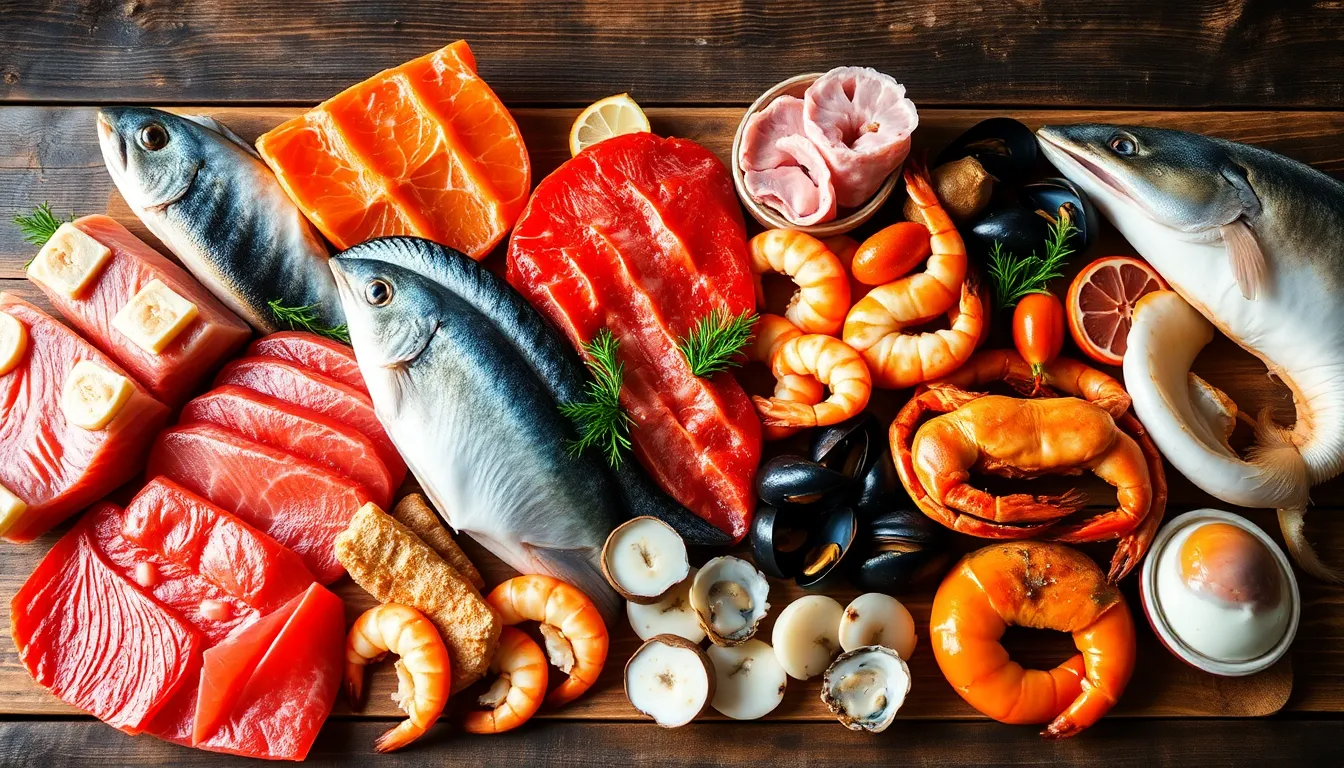When it comes to seafood, nothing beats the fresh, vibrant flavors of wild caught varieties. These fish and shellfish not only offer superior taste but also come with the assurance of sustainability. As consumers become more conscious about their food choices, wild caught seafood stands out as a delicious and eco-friendly option.
Exploring wild caught seafood recipes opens up a world of culinary possibilities. From zesty grilled salmon to savory shrimp tacos, these dishes can elevate any dining experience. Whether you’re a seasoned chef or a home cook looking to impress, incorporating wild caught seafood into your meals adds a unique flair that’s hard to resist. Get ready to dive into the ocean of flavors and discover how easy it is to create mouthwatering meals that are both nutritious and satisfying.
Table of Contents
ToggleBenefits Of Wild Caught Seafood
Wild caught seafood offers numerous advantages, especially regarding nutrition and environmental sustainability. These benefits make it a compelling choice for health-conscious consumers and environmentally aware individuals.
Nutritional Value
Wild caught seafood is rich in high-quality protein, omega-3 fatty acids, vitamins, and minerals. Nutritionists often recommend it for its heart-healthy fats, which support cardiovascular health. A 3.5-ounce serving of wild salmon contains about 25 grams of protein and over 2 grams of omega-3s, contributing to a balanced diet. Additionally, wild caught seafood includes essential nutrients like vitamin D and selenium, which help boost the immune system and support bone health.
Environmental Impact
Wild caught seafood generally has a lower environmental footprint compared to farmed fish. Sustainable fishing practices help maintain fish populations and protect marine ecosystems. According to the Marine Stewardship Council, selecting seafood sourced from certified sustainable fisheries promotes biodiversity and promotes responsible harvesting methods. When consumers choose wild caught seafood, they contribute to the preservation of coastal habitats and the overall health of oceans.
Popular Wild Caught Seafood Types

Wild caught seafood includes a diverse array of fish and shellfish, each offering unique flavors and culinary applications. Understanding these options helps consumers make informed choices.
Fish Varieties
- Salmon: Known for its rich flavor and pink flesh, salmon is high in omega-3 fatty acids and vitamin D. Varieties include Chinook, Coho, and Sockeye, each providing distinct taste profiles.
- Tuna: This firm-fleshed fish offers a meaty texture and comes in types such as Yellowfin and Albacore. Tuna is rich in protein and low in fat, making it a popular choice for steaks and sushi.
- Cod: Available as Atlantic and Pacific varieties, cod has a mild taste and flaky texture. Cod is an excellent source of protein and provides essential nutrients like vitamin B12 and selenium.
- Halibut: This flatfish features a mild flavor and firm texture, suitable for grilling or baking. Halibut is low in fat and high in protein, making it a healthy seafood choice.
- Sardines: Packed with omega-3s and vitamin B12, sardines are small fish typically enjoyed canned or grilled. They are an economical source of lean protein and healthy fats.
Shellfish Options
- Shrimp: With a sweet, delicate flavor, wild caught shrimp is often used in various cuisines, from shrimp scampi to gumbo. It’s high in protein and low in calories.
- Scallops: Known for their sweet taste and tender texture, scallops are versatile and can be pan-seared or baked. They’re high in protein and low in fat.
- Mussels: These shellfish offer a mild, slightly sweet flavor and are high in protein, omega-3s, and iron. Mussels are often steamed and served with broth or sauces.
- Oysters: Renowned for their briny taste, oysters are consumed raw or cooked. They’re rich in zinc and other nutrients that promote healthy immune function.
- Crab: Varieties such as Blue and Dungeness crab provide a sweet, succulent taste. Crab is high in protein and contains essential nutrients like vitamin B12 and omega-3s.
Flavor Profiles In Wild Caught Seafood
Wild caught seafood presents a spectrum of flavors ranging from mild to bold. These distinct flavor profiles enhance various dishes, making them appealing to diverse palates.
Mild Flavors
Mild-flavored wild caught seafood includes varieties like cod, halibut, and sole.
- Cod: Delivers a subtle, slightly sweet taste that pairs well with light sauces.
- Halibut: Features a delicate, flaky texture and blends seamlessly with herbs and citrus.
- Sole: Offers a mild sweetness and can be sautéed or baked without overpowering seasonings.
Mild seafood works well in dishes where more robust flavors are not desirable, serving as a versatile canvas for sauces and spices.
Bold Flavors
Bold-flavored wild caught seafood consists of species such as salmon, tuna, and mackerel.
- Salmon: Known for its rich, fatty texture and deep flavor, it thrives with bold marinades and grilling.
- Tuna: Offers a firm, meaty quality, often served raw in sushi or seared for a savory experience.
- Mackerel: Characterized by its oily richness, it pairs exceptionally well with acidic elements like citrus.
Bold seafood stands out in dishes, making them ideal for showcasing vibrant seasonings and ingredients.
Delicious Wild Caught Seafood Recipes
Wild caught seafood presents versatile and delicious opportunities for home cooks and chefs alike. Here are some remarkable ways to prepare this exquisite ingredient.
Grilled Seafood Dishes
Grilling brings out the rich flavors of wild caught seafood. Popular options include:
- Grilled Salmon: Marinate salmon fillets in olive oil, lemon juice, and herbs. Grill for 6-8 minutes per side until flaky.
- Grilled Shrimp Skewers: Thread shrimp onto skewers, season with garlic, lime, and chili. Grill for about 2-3 minutes per side.
- Grilled Halibut: Brush halibut steaks with a mix of soy sauce and honey. Grill each side for approximately 4-5 minutes until cooked through.
- Grilled Mackerel: Season mackerel with salt and pepper, grill skin-side down for 6-8 minutes for crispy skin.
Seafood Stews and Soups
Seafood stews and soups offer heartwarming meals packed with flavor. Consider these recipes:
- Cioppino: Combine shrimp, clams, mussels, and fish in a tomato broth. Simmer with garlic and herbs for a rich, comforting dish.
- Seafood Chowder: Utilize cod, shrimp, and clams in a creamy base with potatoes and corn. Cook until thickened and hearty.
- Bouillabaisse: Use assorted fish, shellfish, and aromatic spices in a saffron-infused broth. Serve with crusty bread to soak up the flavors.
- Tom Yum Soup: Incorporate shrimp and mussels in a tangy broth with lemongrass, lime leaves, and chili for a spicy kick.
Seafood Salads
- Shrimp Salad: Mix boiled shrimp with avocado, cucumber, and a light vinaigrette for a refreshing dish.
- Tuna Salad: Combine canned tuna with celery, red onion, and Greek yogurt. Serve on greens or in a sandwich.
- Crab Louie Salad: Arrange crab meat with lettuce, tomatoes, and hard-boiled eggs. Drizzle with a tangy dressing for added zest.
- Seared Scallop Salad: Sear scallops and toss them with mixed greens, citrus segments, and a citrus vinaigrette for a delightful contrast.
Tips For Selecting And Preparing Wild Caught Seafood
Selecting and preparing wild caught seafood requires attention to detail for the best culinary experience. Freshness and cooking techniques play crucial roles in achieving optimal flavor and nutrition.
Freshness Indicators
When selecting wild caught seafood, consider these freshness indicators:
- Appearance: Opt for seafood with clear, bright eyes and shiny skin. Dull colors may indicate aging.
- Smell: Fresh seafood has a mild, ocean-like scent. A strong, fishy odor suggests it may not be fresh.
- Texture: Press the flesh gently; it should be firm and bounce back. Soft or mushy flesh indicates poor quality.
- Gills: For whole fish, check the gills, which should be bright red or pink. Brown or gray gills signify staleness.
- Shell: For shellfish, look for tightly closed shells. Open shells that do not close when tapped are dead and should be avoided.
Cooking Techniques
Utilizing proper cooking techniques enhances the flavors and textures of wild caught seafood. Consider these methods:
- Grilling: Imparts a smoky flavor while maintaining moisture. Ideal for thicker fillets like salmon and tuna.
- Baking: Provides even cooking and retains moisture. Season the fish and wrap it in parchment for a deliciously tender outcome.
- Sautéing: Quickly cooks seafood over high heat, creating a flavorful crust. Suitable for shrimp and scallops, this method showcases their natural sweetness.
- Poaching: Gently cooks seafood in simmering liquid, preserving delicate flavors. This technique works well for fish like cod or sole.
- Steaming: Maintains moisture and nutrients. Ideal for shellfish such as clams and mussels, this method ensures tenderness without added fat.
Incorporating these freshness indicators and cooking techniques ensures a delightful wild caught seafood experience.
Embracing wild caught seafood opens up a world of culinary delights. From its exceptional taste to its impressive nutritional profile, it’s a choice that benefits both the consumer and the environment. By exploring various recipes and cooking techniques, anyone can elevate their meals while supporting sustainable practices.
Incorporating wild caught seafood into everyday cooking not only enhances flavor but also promotes health. With an array of options available, there’s something to satisfy every palate. Whether it’s a simple grilled dish or an elaborate seafood stew, the possibilities are endless. Choosing wild caught seafood is more than just a meal; it’s a step towards a healthier lifestyle and a healthier planet.




